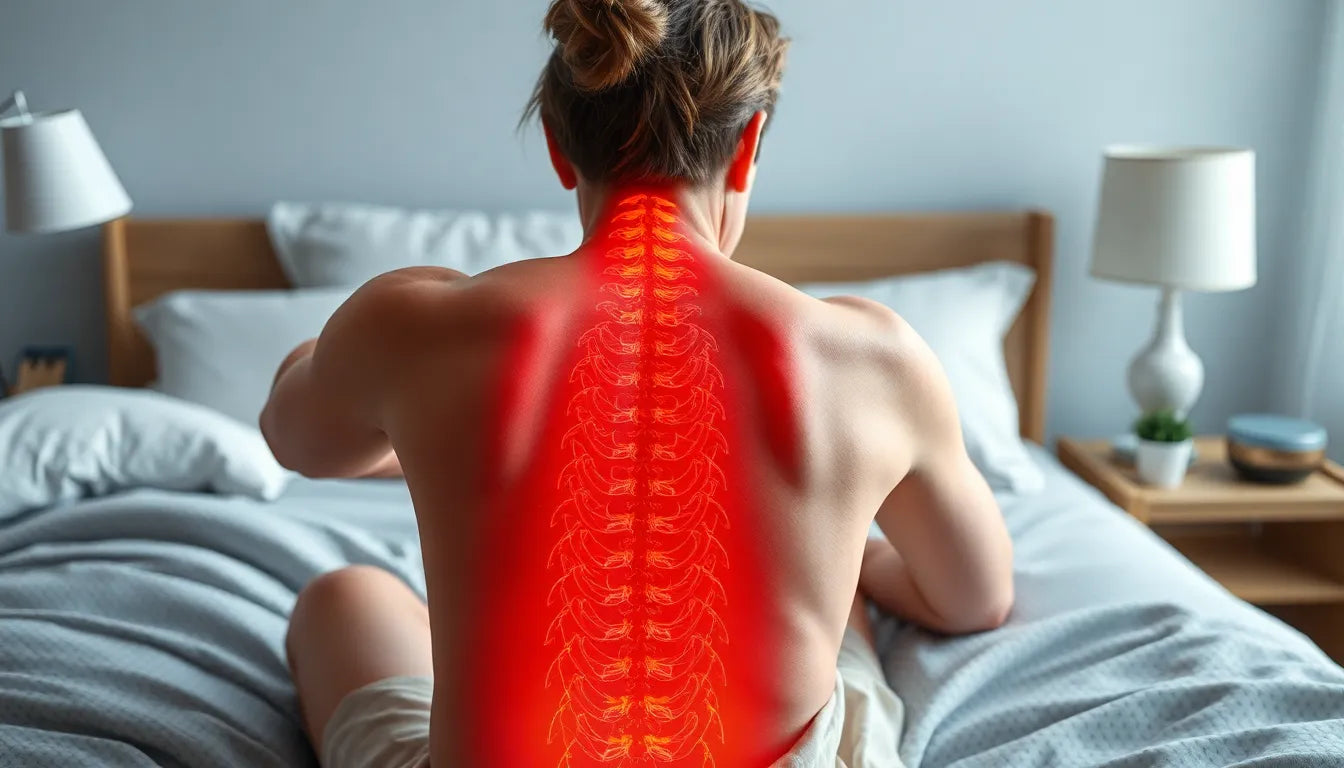Experiencing pain that starts in the lower back and travels down to the buttocks is a common issue that affects many individuals, impacting their daily activities and overall quality of life. This type of discomfort can be debilitating, making even simple tasks like sitting or walking challenging. Understanding the nature of this pain and its underlying causes is crucial for finding effective relief and regaining comfort in everyday life.
Common causes of pain from the lower back to the buttocks
The pain journey from the lower back to the buttocks can stem from several common causes. One of the primary culprits is issues related to the sciatic nerve, which is the longest nerve in the body. When this nerve becomes irritated or compressed, it can lead to sharp, burning pain that radiates from the lower back down to the buttocks and even further down the leg.
Another frequent cause is a herniated disc. This condition occurs when the soft inner material of a spinal disc protrudes through a tear in its outer layer, pressing on nearby nerve roots. This pressure can result in pain that spreads from the lower back to the buttocks, often accompanied by symptoms such as numbness or tingling.
Muscle tension, particularly in the lower back and buttocks, is also a significant contributor to this type of pain. When muscles are tight or overworked, they can cause discomfort that radiates across the lower body. Additionally, piriformis syndrome, a condition where the piriformis muscle compresses the sciatic nerve, can lead to similar symptoms.
Engaging with your pain experience
Have you ever found yourself struggling with pain that seems to travel from your lower back to your buttocks? If so, you're not alone. Many people are on a quest for effective relief from this pervasive discomfort. Understanding the root causes and characteristics of your pain is the first step towards finding a solution that works for you.
In the following sections, we will delve deeper into the specific conditions that can cause this pain and explore strategies for alleviation and prevention. Whether you're dealing with sciatic nerve irritation, a herniated disc, or muscle tension, there are practical steps you can take to manage your symptoms and improve your quality of life.
Sciatic nerve pain: understanding the pathway
The sciatic nerve, the largest and longest nerve in the human body, plays a critical role in transmitting signals from the lower back to the legs and feet. Originating from the lower spine, it travels through the buttocks and down each leg. When this nerve is irritated or compressed, it can result in a condition commonly known as sciatica. This condition is characterized by sharp, burning pain that radiates from the lower back into the buttocks and can extend further down the leg.

Lumbar support belt
Provides adjustable compression for lower back pain, sciatica, or herniated discs.
Compression of the sciatic nerve can occur due to various factors, including herniated discs, bone spurs, or even muscle tension. The resulting pain can be debilitating, affecting mobility and quality of life. Symptoms often include a burning sensation, numbness, or tingling along the nerve's path. Understanding the sciatic nerve's role in this pain can help in identifying effective treatment options.
Herniated disc: a common culprit
A herniated disc is another frequent cause of pain radiating from the lower back to the buttocks. This condition occurs when the soft, gel-like center of a spinal disc pushes through a crack in the tougher exterior casing. This protrusion can press on nearby nerve roots, including the sciatic nerve, leading to pain that spreads to the buttocks and sometimes down the leg.
Symptoms of a herniated disc can vary but often include localized back pain, numbness, tingling, and muscle weakness in the affected area. The pain is typically aggravated by certain movements or positions, such as sitting or bending forward. Accurate diagnosis through imaging tests like MRI or CT scans is essential for effective management and treatment of this condition.
Muscle tension and piriformis syndrome
Muscle tension in the lower back and buttocks is another significant contributor to pain that radiates to the buttocks. When muscles are tight or overworked, they can create discomfort that affects the lower body. Factors such as poor posture, prolonged sitting, or lack of physical activity can exacerbate muscle tension.
Piriformis syndrome is a specific condition where the piriformis muscle, located deep in the buttocks, compresses the sciatic nerve. This compression can lead to symptoms similar to sciatica, including pain, numbness, and tingling. It is often caused by repetitive activities or prolonged sitting, which can tighten the piriformis muscle and irritate the sciatic nerve.
Recognizing symptoms and the importance of diagnosis
Recognizing the symptoms of these conditions is crucial for seeking appropriate treatment. Common symptoms include pain that radiates from the lower back to the buttocks, numbness, tingling, and muscle weakness. These symptoms can vary in intensity and may worsen with certain activities or positions.
Proper diagnosis is essential to distinguish between these conditions and determine the most effective treatment plan. Healthcare professionals can perform physical examinations and diagnostic tests to identify the underlying cause of the pain. Early diagnosis and intervention can prevent the condition from worsening and improve the chances of successful treatment.
In the next section, we will explore various treatment and relief strategies to help alleviate pain and improve your quality of life. Whether your pain is due to sciatic nerve irritation, a herniated disc, or muscle tension, there are practical steps you can take to manage your symptoms effectively.
Treatment and relief strategies for pain from the lower back to the buttocks
Managing pain that radiates from the lower back to the buttocks involves a combination of strategies aimed at alleviating symptoms and preventing future discomfort. One of the most effective approaches is maintaining regular physical activity. Engaging in gentle exercises and avoiding prolonged periods of inactivity can help reduce pain and improve mobility. It's essential to change positions frequently, whether sitting or standing, to prevent stiffness and muscle tension.
Physical therapy and targeted exercises
Physical therapy plays a crucial role in managing pain associated with conditions like sciatica, herniated discs, and piriformis syndrome. A physiotherapist can tailor a program that includes exercises designed to mobilize nerves, relax muscles, and improve posture. Techniques such as McKenzie exercises are particularly beneficial for those with herniated discs, as they help reduce pressure on the spinal discs and alleviate pain. Additionally, general back and buttock exercises can strengthen the muscles and enhance flexibility, contributing to long-term relief.

Men's Posture Shirt™ - Black
Improves posture, activates muscles, and can help relieve pain and tension daily.
Massage and manual therapy
Massage and manual therapy can also be effective in relieving muscle tension and reducing pain. These therapies focus on loosening tight muscles, improving circulation, and promoting relaxation. By addressing muscle imbalances and tension, massage can help alleviate discomfort and prevent further irritation of the sciatic nerve or other affected areas.
Consulting a healthcare professional
If pain persists beyond a few weeks or worsens, it's advisable to seek professional medical advice. A healthcare provider can perform a thorough evaluation to determine the underlying cause of the pain and recommend appropriate treatment options. This may include imaging tests, medication, or referrals to specialists for further management.
Prevention tips for avoiding recurring pain
Preventing pain from recurring involves adopting healthy lifestyle habits and ergonomic practices. Maintaining good posture, especially while sitting, can significantly reduce the risk of developing pain. Ergonomic chairs and workstations that support the natural curve of the spine can help maintain proper alignment.
Regular physical activity is also vital for prevention. Engaging in exercises that strengthen the core and lower back muscles can provide stability and support to the spine. Incorporating stretching routines into your daily regimen can improve flexibility and reduce muscle tension.
To assist in maintaining these habits, consider using a preventive checklist. Assess your daily activities and environments to ensure they support your posture and physical health. Simple adjustments, like taking regular breaks to stand and stretch, can make a significant difference in preventing pain.
Frequently Asked Questions
What is the most common cause of pain from the lower back to the buttocks?
The sciatic nerve is often the primary culprit. Irritation or compression of this nerve can lead to radiating pain that starts in the lower back and travels to the buttocks.
How can I differentiate between a herniated disc and other causes?
A healthcare professional can perform diagnostic tests, such as MRI or CT scans, to identify the specific cause of pain and differentiate between a herniated disc and other conditions.
Are there exercises I can do at home to relieve pain?
Yes, exercises like McKenzie exercises are beneficial for relieving pain. It's recommended to consult a physiotherapist for personalized guidance and to ensure exercises are performed correctly.
When should I seek medical attention for my pain?
If the pain persists for more than a few weeks, worsens, or is accompanied by severe symptoms like loss of bladder control or significant weakness, it is advisable to seek professional evaluation promptly.


















